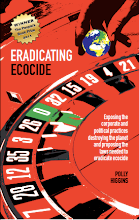 Last week, on the 12th November, the Bolivian Ambassador Mr. Pablo Solon presented to the UN a Draft Resolution Presentation Speech “Harmony with Mother Earth” co-sponsored by Algeria, Benin, Belarus, Bosnia and Herzegovina, Cape Verde, Cuba, Dominica, Ecuador, Eritrea, Georgia, Guatemala, Honduras, Mauritius, Nepal, Nicaragua, Paraguay, Saint Vincent and the Grenadines, Saint Lucia, Seychelles and Venezuela. The resolution seeks recognition of the Earth as a Whole and the interaction of human beings with that system of which we are a part.
Last week, on the 12th November, the Bolivian Ambassador Mr. Pablo Solon presented to the UN a Draft Resolution Presentation Speech “Harmony with Mother Earth” co-sponsored by Algeria, Benin, Belarus, Bosnia and Herzegovina, Cape Verde, Cuba, Dominica, Ecuador, Eritrea, Georgia, Guatemala, Honduras, Mauritius, Nepal, Nicaragua, Paraguay, Saint Vincent and the Grenadines, Saint Lucia, Seychelles and Venezuela. The resolution seeks recognition of the Earth as a Whole and the interaction of human beings with that system of which we are a part.Mr Solon stated to the UN: “We acknowledge and share the progress of the environmental agenda of the United Nations at the level of the biodiversity, the ozone layer, desertification, climate change and other sectors, but we are convinced that this needs to be supplemented with a more holistic approach given the serious global impacts we are witnessing.”
Of the approximately 200 items that the United Nations General Assembly Agenda has, about 10 deal with the environment and sustainable development, and none directly addresses the holistic, global and integrated relationship among human beings and the earth system as a whole. This parallels the focus of the forthcoming international climate change negotiations on the imposed value (i.e. the price we place on the planet’s resources; the financing of reduction of carbon emissions by use of carbon trading etc). To include recognition of the intrinsic value of the planet, as a living being with whom we have an interdependent relationship, would be an acknowledgment of Earth as a Whole, a concept Indigenous communities understand well.
Values: imposed v's intrinsic
It is the difference between treating the planet as a commodity and taking responsibility. Both start with very different paradigms. The former, from a position of viewing the planet as an inert being, from which we can take without consequence. The latter, a position of understanding the planet as a living being, where we are all interconnected and interdependent. The outcomes of such divergent views are dramatic - and we can see them being played out in the international climate change arena today.
 It is not only the 350+ million indigenous peoples of the world and by a similar number of Buddhists who adhere by the intrinsic values of the planet: "1,360 experts from 95 countries that participated in the Millennium Ecosystem Assessment ...propose that when analyzing and defining the actions that influence ecosystems it is necessary to consider not only welfare of human beings, but also the intrinsic values of the species and ecosystems."
It is not only the 350+ million indigenous peoples of the world and by a similar number of Buddhists who adhere by the intrinsic values of the planet: "1,360 experts from 95 countries that participated in the Millennium Ecosystem Assessment ...propose that when analyzing and defining the actions that influence ecosystems it is necessary to consider not only welfare of human beings, but also the intrinsic values of the species and ecosystems."Mr Solon’s proposal, supported by the 22 nations, for “a possible declaration of ethical principles and values to a life in harmony with Mother Earth” signals a growing momentum for recognition of what the Bolivian indigenous peoples term ‘buen vivir’ or ‘living well’ and in harmony with nature - a vision shared by many others throughout the world. The new paradigm is starting to take shape.






